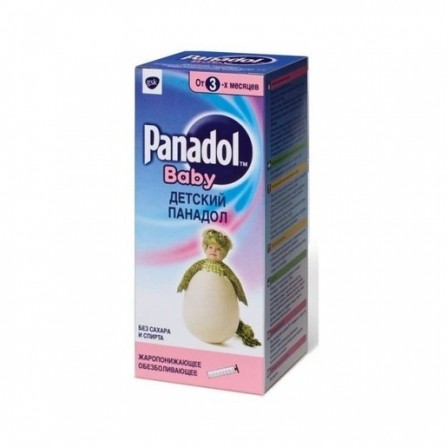Panadol Children's oral suspension 100 ml
Condition: New product
1000 Items
Rating:
Be the first to write a review!

More info
Description
Suspension "Panadol" has analgesic, antipyretic and weak anti-inflammatory effect.
Active ingredients
Paracetamol
Release form
Suspension
Composition
Every 5 ml of suspension contains: active ingredient - paracetamol 120 mg; inactive ingredients: malic acid, xantamic gum, glucose syrup hydrogenate (maltitol), sorbitol, citric acid, sodium nipasept, strawberry flavor, azorubine, water. Panadol for children does not contain sugar, alcohol and acetylsalicylic acid.
Pharmacological effect
Analgesic antipyretic. It has analgesic, antipyretic and weak anti-inflammatory action. The mechanism of action is associated with inhibition of prostaglandin synthesis, a predominant effect on the center of thermoregulation in the hypothalamus.
Pharmacokinetics
After ingestion, paracetamol is rapidly absorbed from the gastrointestinal tract, mainly in the small intestine, mainly by passive transport. After a single dose of 500 mg Cmax in plasma, it is reached in 10-60 minutes and is about 6 μg / ml, then gradually decreases and after 6 h it is 11-12 μg / ml. Widely distributed in tissues and mainly in body fluids, with the exception of adipose tissue and cerebrospinal fluid. Protein binding is less than 10% and increases slightly with overdose. Sulfate and glucuronide metabolites do not bind to plasma proteins even in relatively high concentrations. Paracetamol is metabolized predominantly in the liver by conjugation with glucuronide, conjugation with sulfate and oxidation with the participation of mixed liver oxidases and cytochrome P450. A hydroxylated negative-acting metabolite, N-acetyl-p-benzoquinone imine, which is formed in very small amounts in the liver and kidneys under the influence of mixed oxidases and is usually detoxified by binding to glutathione, can be heated by an overdose of paracetamol and cause tissue damage. In adults, most of the paracetamol is associated with glucuronic acid and to a lesser extent with sulfuric acid. These conjugated metabolites do not possess biological activity. Premature babies, newborns and the first year of life are dominated by the sulfate metabolite. T1 / 2 is 1-3 hours. In patients with cirrhosis, T1 / 2 is slightly larger.Renal clearance of paracetamol is 5%. Excreted in the urine mainly in the form of glucuronide and sulfate conjugates. Less than 5% is excreted as unchanged paracetamol.
Indications
Pain syndrome of low and moderate intensity of various genesis (including headache, migraine, toothache, neuralgia, myalgia, algomenorrhea, pain with injuries, burns). Fever in infectious and inflammatory diseases.
Contraindications
hypersensitivity to paracetamol or any other ingredient of the drug; severe impaired liver or kidney function; neonatal period;
Precautionary measures
Use with caution in impaired liver function (including Gilbert's syndrome), kidneys, genetic absence of the enzyme glucose-6-phosphate dehydrogenase, severe blood diseases (severe anemia, leukopenia, thrombocytopenia). In such cases, before taking the drug should consult a doctor. The drug should not be taken simultaneously with other paracetamol-containing drugs.
Dosage and administration
Inside in adults and adolescents weighing more than 60 kg is used in a single dose of 500 mg, the multiplicity of reception - up to 4 times / day. The maximum duration of treatment is 5-7 days. Maximum doses: single - 1 g, daily - 4 g. Single doses for oral administration for children aged 6-12 years - 250-500 mg, 1-5 years - 120-250 mg, from 3 months to 1 year - 60 -120 mg, up to 3 months - 10 mg / kg. Single doses for rectal use in children aged 6-12 years - 250-500 mg, 1-5 years - 125-250 mg. The frequency of use is 4 times / day with an interval of at least 4 hours. The maximum duration of treatment is 3 days. Maximum dose: 4 single doses per day.
Side effects
In recommended doses, paracetamol rarely has a side effect. Sometimes nausea, vomiting, pain in the stomach, allergic reactions (skin rash, itching, urticaria, angioedema) are possible. Rarely - anemia, thrombocytopenia, leukopenia. If you experience adverse reactions, immediately stop taking the drug and consult a doctor.
Overdose
Symptoms of acute poisoning with paracetamol are nausea, vomiting, stomach pain, sweating, pallor of the skin. After 1-2 days, signs of liver damage are determined (tenderness in the liver area, increased activity of liver enzymes).In severe cases, liver failure, encephalopathy and a coma develop. With prolonged use in excess of the recommended dose, hepatotoxic and nephrotoxic effects (renal colic, nonspecific bacteriuria, interstitial nephritis, papillary necrosis) can be observed. Acetylcysteine is a specific antidote for paracetamol poisoning. In case of an accidental overdose, you should immediately seek medical attention. power, even if the child feels good.
Interaction with other drugs
When using Pediatric Panadol with barbiturates, difenin, anticonvulsants, rifampicin, Butanedione, the risk of hepatotoxic action may increase. If taken simultaneously with levomycetin (chloramphenicol), the toxicity of the latter can be increased. The anticoagulant effect of warfarin and other coumarin derivatives may increase with the long-term regular use of paracetamol, which increases the risk of bleeding.
special instructions
Children from 2 to 3 months and children born premature Baby Panadol can be given only as prescribed by a doctor. When conducting tests for the determination of uric acid and blood sugar levels, inform your doctor about the use of Pediatric Panadol. When you are taking the drug for more than 7 days, it is recommended to monitor peripheral blood parameters and the functional state of the liver. For children 2 th-3rd month of life, a single dose is possible to reduce the temperature after vaccination. If the temperature does not decrease, consult a doctor.





